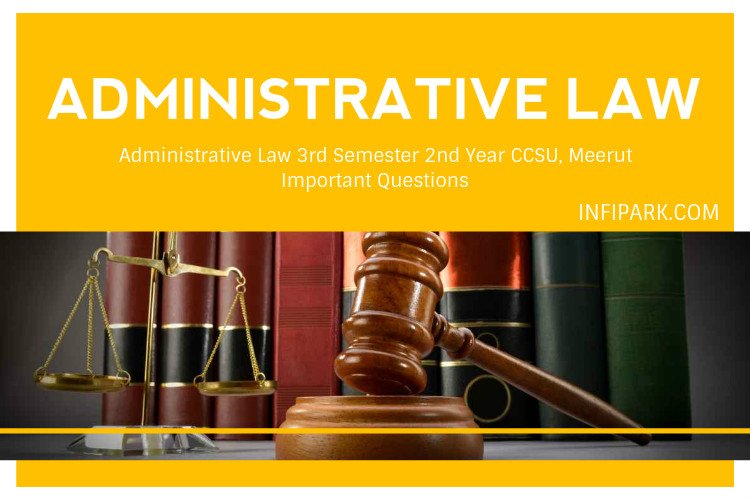Q. 1 (a). Point out and explain the origin and development of Administrative Law in India from ancient period to present day. Or Explain about the causes of the development of Administrative law in India after obtaining the independence.
Q.1(b). Discuss about the sources of Administrative Law in India.
Q.2(a). What is Administrative Law? Explain its nature and scope.
(b) Point out the difference between Administrative Law and Constitutional Law?
(c) Discuss the causes for the growth or reasons of the importance of Administrative Law.
Q.3a). What do you mean by the doctrine of’ droitAdministratif? Explain its characteristic features. Explain the merits of the system. Also state the composite and working of conseild Etat. b) What is the difference between Administrative law and Droit Administratif.
Q.4. Define the term ‘Rule ofLaw’. How has this doctrine been applied in India? Is Rule of Law repugnant toAdministrative Law? What do you understand by ‘Rule of Law’? What is the importance of ‘Rule of law’ for a welfare State?Or `The Rule of law’ postulates the persuasiveness to the spirit of law throughout the whole range of Government in the sense of excluding arbitrary official action in any sphere.Or Explain fully the dicey’s concept of the Rule of law.
Q.5. What do you mean by the Doctrine of ‘Separation of Powers’? Describe its importance in the context ofAdministrative Law.
Or
`The Indian Constitution has not indeed recognized the Doctrine of Separation of Power in its absolute rigidity but the functions of different branches of the Government have been sufficiently differentiated.’ Discuss.
Or
`The Doctrine of Separation ofPower is not fully applicable in India’. Comment Or Explain Montesquieu’s theory of Separation of Power and examine its cpplicatioit «Rhin Indian Constitution.
Q.6a). What do you understand by delegated legistation? Discuss the various methods ofjudicial control over delegated legislation.
Q.6b). Examine the various methods of Legislative control over Delegated Legislation. What is the effect of failure to lay? What are the various kinds of laying?
Q.6c). I-low the Parliament exercises procedural control over Delegated Legislation? Also discuss the effect of failure to exercise of procedural control?
Q.6d). Examine the various causes of the growth of Delegated Legislation and also Explain the classification of Delegated Legislation.Or Discuss necessity for the delegation of Legislative Powers to the Executive.
Q.6e). Explain the constitutionality of the delegated legislation in India. What functions cannot be delegated under impermissible delegation?
Q.6(f). Discuss those legislative functions which can be delegated and which can not be delegated?
Q.6g). What is excessive delegation? Does the Court disapprove the practice of excessive delegation?
Q.7a). Explain the various kinds of classification of Administrative Action with examples. What is legislative, judicial and Administrative Action? Also explain the Quasi-legislative and Quasi-judicial Actions.
(b) Distinguish between (i) Quasi-legislative and quasi-judicial actions; (ii) Legislative and Judicial Actions; (iii) Legislative and Administrative Actions; (iv) Judicial,Quasi-judicial and Administrative Actions; (v) Administrative and Quasi-judicial Actions.
Q.8a). What is Administrative Instruction and Administrative Direction? Explain their effects on individual’s rights and enforceability. (b) Define and explain “Administrative Discretion”. To what extent the exercise ofAdministrative discretion is subject to Judicial Control?Or Discuss the Scope ofJudicial Review ofAdm inistrative discretion?
Q.9. What do you mean by Ombudsman (Lokpal)? What steps had been taken in India for establishing this institution?
Or
Explain whether the institution of0mbudsman is feasible in India for redressal ofgrievance of c itizens against mal-administration.Or Describe the function and powers ofl,okayukta? What is the position of Ombudsman in India?
Q.10a). What do you mean by Natural Justice? Discuss. Or National justice is the name given to certain fundamental rules which are so necessary to the proper exercise of power, that these are protected from the judicial to administrative sphere. Comment.
Q.10b). How far is the requirement of giving a reasoned decision a component of natural justice?
Q.10c). ‘No Person shall be a judge in his own cause.’ Comment.Or What is the effect of ‘Bias’ on the administrative authority? Point out the different kinds of `Bias’.0r Explain the application ofthe ‘Rule against Bias’ making reference to the decided cases.
Q.10d). What do you mean by ‘Audi Alteram Partem’ and also state the exception to the principle.Or `No person shall be condemned unheard’. Explain and illustrate the above rule.
Q.11 a). What do you understand by Administrative Tribunal? Distinguish it from the Court.
Q.11 b). Discuss the circumstances which necessiated the creation of Administrative tribunals.
Q.12. What do you understand by prerogative writs? Discuss the nature, scope and object of Habeas Corpus.
Or
Can successive applications for Habeas Corpus be moved? Explain the procedure and grounds of issuing of Habeas Corpus. Who may apply for it?
Q.13 a). Discuss the growth ofthe Administrative Tribunals in India.
Q.13 b). Describe Central Administrative Tribunal. Discuss the objects of its establishment.
Q.14. Are the powers of the supreme court under Article 32 of the Constitution of India very wide? Express your opinion giving illustrations.Or Discuss the remedies available under Article 32 of the Constitution.
Q.15. Explain the writ jurisdiction ofthe High Courts in India under Art. 226 of the Constitution.
Or
What is the scope of the writ issuing powers conferred on High Courts underArt. 226 to check the administrative authorities from assuming arbitrary powers?
Or
Discuss the limitations which the High Court may itself place for the exercise °fits jurisdiction.
Q.16a). Discuss the nature, scope and object of the writ of certiorari. What are the grounds on the basis of which it can be issued? Can it be issued to call for the proceedings of an Act or Ordinance?
Q.16b). Discuss the meaning, nature and scope ofthe writ of Prohibition. Also state the grounds on the basis of which it can be issued.
Q.16c). Explain the meaning, nature, scope and object of the writ of Mandamus. What are the conditions and grounds on which it can be issued? Who may apply for it? Against whom mandamus will not apply? What remedies are provided by it?
Q.16d). Discuss the meaning, nature, scope and object of the Quo-warranto. What are the conditions of its issuing? Who may apply for? When can it be refused?
Q.17a). What do you understand by “Public Interest Litigation” (PIL)? Is it an exception to the “Locus Standi”? What is the object of Public Interest Litigation? On what grounds the court would allow litigation in public interest? Give some illustrative cases where the court allowed P.I.L.
Q.17b). What are the abuses or demerits of Public Interest Litigation? How the defects of P.I.L. may be removed?
Q.18a). Describe the contractual liability ofthe Government?
Q. I 8b). Discuss the tortious liability of the Government for torts committed by its servants during the course oftheir employment
Q.19. What is legitimate expectation? Refer to decided support ofyour answer. Also discuss the importance and development of the doctrine of legitimate expectation in India.
Q.20a). Discuss the ordinary remedies available to an aggrieved person on against the wrongful acts of the Administrative action?Or Write notes on Injunction, Declaration and Action for Damages.
Q.20b). Examine the Constitutional safeguards available to the civil servants in India. Do these safeguards apply to the
(a) Members of the Defence Forces,
(b) Employees ofthe Public Corporation and
(c) Employees of a University?
Or
Discuss the doctrine of pleasure. What protections have been afforded to a civil servant by Art. 311 against arbitrary dismissal, removal or reduction in rank of civil servants? State the circumstances under which the said protections are not available.










